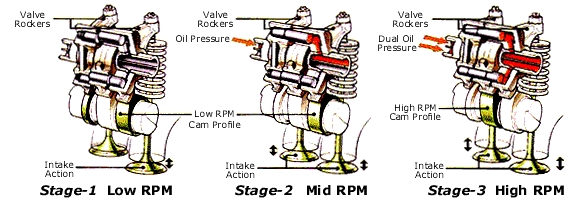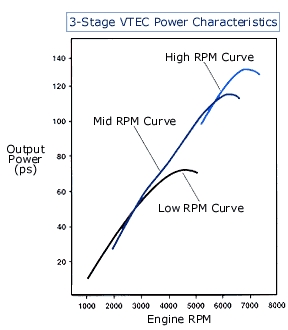
|
Home VTEC - Home What's VTEC? Why do I want it? How does it work? DOHC VTEC SOHC VTEC SOHC VTEC-E 3-Stage VTEC VTEC Misconceptions |

All the work Honda has done on the VTEC mechanism are combined to make the 3-Stage
VTEC system. It is not a rumor, the engine exists: D15B. The engine is used in Honda Civics in Europe and Japan.
In short, it combines VTEC-E and SOHC VTEC to get both extraordinarily good RPM fuel economy, and excellent high RPM
power. The D15B is a 1.5L engine that is capable of about 54mpg and is rated for about 128HP. There is no other
engine that can boast such combination of good fuel economy and power output. To understand how it works, it is
recommended that the reader becomes familiar with the DOHC VTEC, SOHC VTEC, and SOHC VTEC-E mechanisms. This
article assumes as such.
 Looking at Stage 1 above, we see that both intake valve rockers operate independently. And at this low RPM, only one intake valve opens and closes since the other intake valve follows an almost-round cam profile. The almost-round cam profile is designed to open the valve just tall enough to avoid pooling of fuel above the valve. This mechanism is just like the low-RPM operation of the VTEC-E mechanism, resulting in great low-RPM fuel economy. Stage 2 in the illustration shows the mid-RPM range operation. Starting at about 2500 RPM, the first oil pressure is applied, pusing a pin to lock the two intake valve rocker arms together. Both valves now follow the same low RPM cam profile in their operation. Thus far the operation has just been like a normal VTEC-E mechanism. In Stage 2 above, the second oil pressure is applied at about 4500 RPM. The second oil pressure pushes another pin through the valve rocker arms and a cam follower that is between the two valve rocker arms. The cam follower operates from the high RPM cam lobe so now both intake valves follow the high RPM cam profile. This is like the high RPM section of an SOHC VTEC engine.  As seen from the power curve graph, each of the three stages has a distinct curve.
And by choosing the switch-over points correctly, the optimal portions for the three stages can be combined into
one curve. This level of low and high RPM optimization is unavailable from any other mass produced commercial
engine.
As seen from the power curve graph, each of the three stages has a distinct curve.
And by choosing the switch-over points correctly, the optimal portions for the three stages can be combined into
one curve. This level of low and high RPM optimization is unavailable from any other mass produced commercial
engine.
It seems that combination of VTEC technologies is where the future lies for Honda engines. Already we are seeing this in mass produced US-spec Hondas: the J30A1 V6 used in Honda Accord V6s has a hybrid VTEC-E and SOHC VTEC system, though not a three-stage system like above. In this system, Stage 2 is not implemented. Only Stage 1 and Stage 3 are used: one intake valves open at low RPM, both intake valves open taller and for longer duration at high RPM. ---------------------------------------------------------------------------------------------------------------------- The info on this page is a copy of the webarchive.org pull of www.leecao.com, which at the time of this posting this (10/31/2007) was no longer a valid site. |